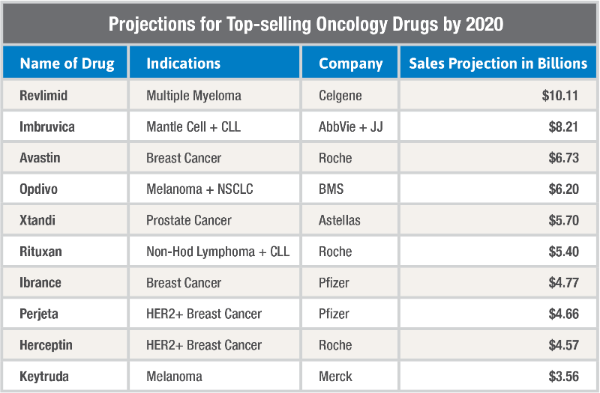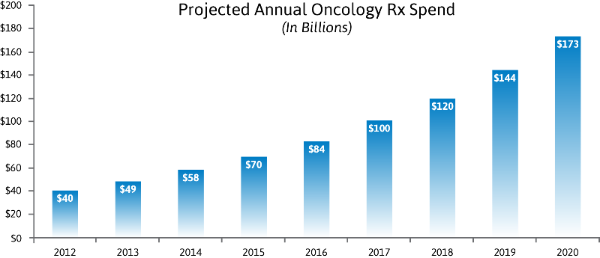How to Spend Your Oncology Money More Wisely
The average cost of a specialty drug has gone up 11% so far in 2015.1 We continue to see large price increases for TNF inhibitors and the new threshold for oncology seems to be in the range of $100,000 to $125,000 per year of treatment. Some of the new oncology treatments show great promise while others appear to offer minimal improvements at a premium price. Figure A lists the top-revenue oncology drugs anticipated over the next five years.
Figure A

The number of new oncology agents and their more substantial costs are challenging to payors. Specialty continues to capture a larger portion of the total prescription cost. An analysis MedImpact recently performed showed specialty prescriptions across our book of business represent 36.8% of total spend. By year end it is likely that number will increase to nearly 40%. The projected oncology numbers in Figure A highlight the impact cancer therapy is having on overall drug spend. Figure B shows Reuters’ projection for the eight years between 2012 and 2020.2 Reuters predicts oncology drug therapy spend will increase four-fold in just eight years.
Figure B

Most clients want to know what can be done about their oncology spend when the consequences of the disease is often dire. No organization wants to prevent a member from obtaining a medication that could save their life. To that end, there are ways to provide effective life-saving cancer therapies to patients and spend our healthcare dollars wisely:
- Ensure the prescribed medication is indicated for patient’s cancer
- Use a split-fill program to avoid waste
- Continue to monitor the patient’s progress to help ensure drug efficacy
Members of the Drug Information Team prepare documents for the MedImpact Pharmacy and Therapeutics Committee (P&T Committee) that contain rigorous assessments on all new oncology medications. These clinicians determine which specific cancer(s) can be treated effectively with specific agents and analyze the drug’s safety profile. They review national guidelines from organizations such as the American Society of Clinical Oncology (ASCO) and the National Comprehensive Cancer Network (NCCN) to determine the order of usage of any oncolytic.
Additionally a separate formulary committee reviews results from the P&T Committee and then determines which oncology medications will provide optimal clinical outcomes and cost. Those medications may be placed in a preferred tier on the formulary with appropriate Prior Authorization (PA) criteria. This process helps ensure the most valuable oncology medications are tried first for any given patient. It also helps ensure that prescriptions for indications other than those where evidence shows they are effective will not be approved.
An effective method to manage oncology spend is to utilize a split-fill program. In MedImpact’s program there are 22 oncology medications appropriate for a split-fill arrangement. These medications require a PA, allowing the pharmacy to dispense only a two-week or 15-day supply at a time for the first two months of therapy. The member pays only half of their copayment for this supply. Because there are a percentage of people who will not tolerate an oncology medication and stop taking it, we can avoid wasting the entire prescribed amount, saving $10,000 to $20,000 for a one-month supply. Our program will monitor the savings a client attains by using the partial-fill approach.
The third way clients can manage their oncology spend is to continue monitoring the patient to determine if the therapy is working. This can be done using the clinical support programs a specialty pharmacy offers. Specialty pharmacies are trained to watch for and mitigate side effects, which can help keep the patient on the best medication. Monitoring the patient also can be accomplished through the PA process, which requires specific genetic tests be performed. Because many tumors mutate over time─which can render the oncolytic ineffective─utilizing the genetic tests at appropriate time intervals, we avoid wasting money on treatments that will provide no clinical benefit to the patient.
Oncology medications can prolong and improve life for many patients and we want to ensure they are available to all who will benefit. We must, however, ensure the evidence─obtained through rigorous clinical trials─shows the costly oncology therapy will potentially lead to a positive outcome. The programs outlined in this article can help clients make the best use of their healthcare spend in oncology.
Steven G. Avey, RPh, MS, FAMCP
Vice President, Specialty Pharmacy Programs
Sources:
- Data collected from MedImpact book of business representing approximately 29M lives
- Reuters article: http://www.reuters.com/article/2012/06/15/us-cancer-cost-idUSBRE85E05B20120615.
